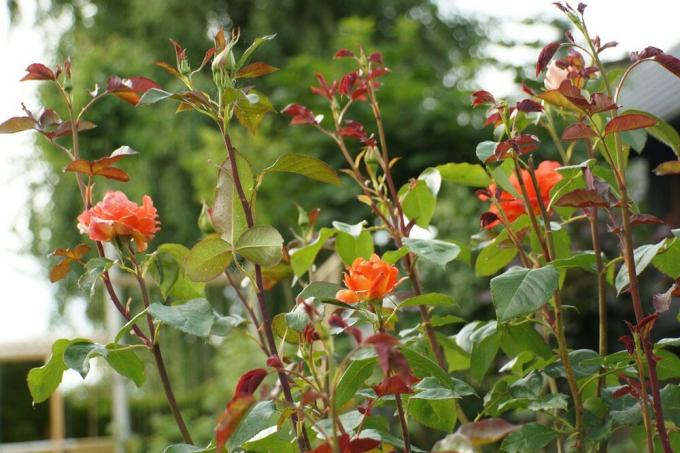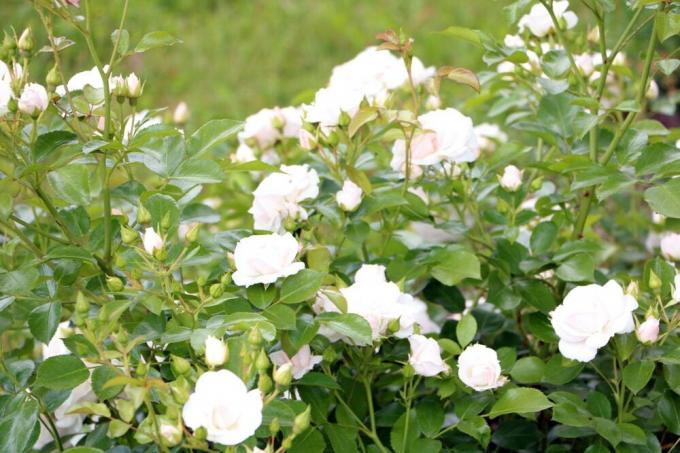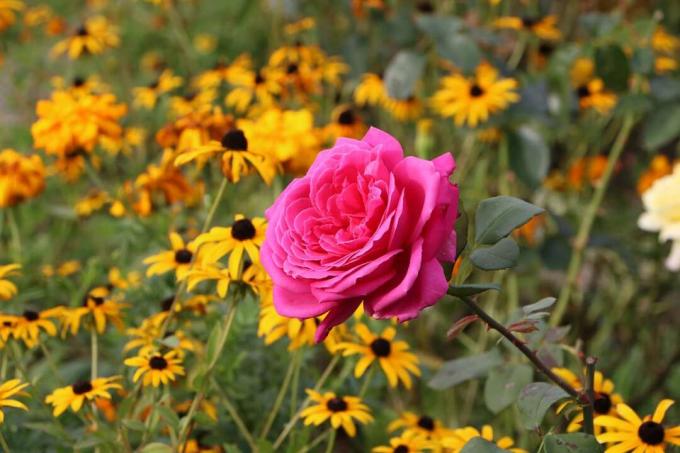

Table of contents
- General information about pruning
- Tool
- bed roses
- Hybrid Tea Roses
- Multi-flowering shrub roses
- Once blooming shrub roses
- small shrub roses
- climbing roses
- standard roses
- avoid errors
- Dispose of clippings
Roses can delight the gardener with their blooms. However, this only applies if they are also cut correctly. Roses that are neglected will not bloom and become old. The hives appear untidy and provide a good base for pests or disease. There are a few things to consider when pruning roses, but it is still worth taking on the task.
General information about pruning
- use sharp, preferably disinfected tools
- Also disinfect tools when changing plants
- right time for most varieties in spring when forsythia are in bloom
- Faded flowers are removed regularly, thus avoiding unnecessary seed formation
- Make the cut at an angle over the outward-facing bud
- dead wood is removed at the base
- diseased wood cut back to healthy
- Regular pruning protects against senescence and keeps flowering
- Strong pruning promotes strong new growth, weak pruning leads to weak new growth
- each type of rose is treated individually
- once flowering varieties cut after flowering
Tool
It is best to use special rose scissors to cut the roses. However, it is also possible to use other pruning shears. A hand saw is necessary for stronger shoots, and perhaps one with a telescopic handle for climbing roses. Another important tool is sturdy gloves, into which the thorns of the rose cannot penetrate.
bed roses

They can be cut back the hardest. Shoots about 15 to 20 cm long remain on the stick. If it is a slow-growing variety, three healthy shoots with three eyes should remain on the cane. If the variety belongs to the strong-growing varieties, 5 shoots can remain on the plant. There should be 5 buds on each shoot. The goal when pruning the bed rose is a compact, floriferous rose with a bushy character. If the shoots stay too long, the plant will fall apart and appear bare.
Hybrid Tea Roses
These roses can also be pruned vigorously. Slow-growing varieties need three to four shoots, fast-growing hybrid tea roses five to six. Strong shoots are cut back to five buds, weak ones to three. The goal is a rose with long, straight buds. Many branches should therefore be avoided. For older specimens of floribunda or bed roses, an old, perennial shoot is always removed at the base to encourage the plant to sprout again.
Tip:
Weak shoots that are too thin are also removed so that stronger growth is stimulated.
Multi-flowering shrub roses
You will be cut less. In addition, a cut in summer is sufficient for once-flowering varieties. Shrub roses bloom on one-year-old wood, which forms on shoots from the previous year. As shrub roses can grow very tall, up to 300cm, some strong, older shoots in the plant are necessary to support them. Similar to the fruit tree pruning, the best and strongest five shoots are selected, these form the basic structure of the rose.
All other long shoots are removed at the base, the same applies to over-aged or weak shoots that did not produce many flowers in the previous year. The branches on the main shoots are cut back to three to five buds, on which the flowering shoots then form.
Once blooming shrub roses
They are basically treated like other shrub roses. However, the cut is made in summer, after flowering. They are also not cut back too much, as they bloom on perennial wood. For older specimens (from about 5 years), an old, thick branch just above the ground is completely removed to encourage new growth of the rose.
Tip:
Old wood can be recognized by the color of the bark. It changes from green to yellow-brown.
small shrub roses

In addition to the large shrub roses, there are also varieties that can be used as ground cover. These are particularly easy to care for and are rarely cut. The main focus is on cutting dead or diseased wood. Too dense shoots are also removed. A strong pruning should be done about every 5 years.
climbing roses
Climbing roses are also best pruned in summer, depending on their size they are shortened by about a third. Since they usually grow on a trellis, those shoots that grow in the wrong direction and cannot be trained are primarily removed. Along the main shoots, all side shoots are cut back to three to five buds. Older shoots should be removed at the base if there is a young shoot that can be raised. The ratio of young wood to old should be roughly balanced.
standard roses
These little saplings should also be treated like trees. When cutting, the goal is a loose, light-flooded and airy crown. Spring is also the right time for multi-flowering varieties. The pruning of once-blooming standard stems takes place after flowering. Standard roses can be pruned naturally or shaped by pruning. However, spherical shapes appear artificial. When pruning roses, about a third of the plant is taken back. Too dense and crossing or obstructing shoots are removed.
avoid errors
Care is taken to proceed evenly when pruning roses. If shoots of different lengths remain on the rose, it can happen that they sprout to varying degrees and continue to grow. The rose bush gets a misshapen appearance. You should also avoid cutting over buds that are growing inwards. The shoots would eventually interfere with each other. A straight, clean cut is important, which is why the tool should be very sharp. The more unclean the cut, the greater the entry point for germs.
Tip:
However, wild shoots at the base of the plant are not cut, they are best torn out so that new ones do not develop in the same place. Wild shoots can be recognized by the fact that they grow out below the grafting point.
Dispose of clippings
If the roses are healthy, the clippings can be used in the garden. It can be planted in the bottom layer of mound or raised beds. Shredded, it serves as mulch for beds or is disposed of in the compost. The situation is different with diseased roses. If possible, these should be disposed of outside the garden. If available, trimmings can be put in the compost bin or they go in the residual waste.
 garden editorial
garden editorial I write about everything that interests me in my garden.
Learn more about roses

What goes with roses: 30 beautiful rose companions
The beauty of roses really comes into its own when surrounded by the right companion plants. It is important for rose companions that they have similar requirements to roses. We tell you what goes well with roses.

Rose soil: mix soil for roses yourself | composition
The rose is considered the queen of flowers and she is very demanding. When it is newly planted, the soil should therefore be optimally prepared. Special rose soils are particularly suitable for planting. How to make them yourself is in this post.

Rose cuttings: 8 tips for propagating roses
Roses can be propagated quite easily with the help of cuttings if the site conditions and the preparation are right. Both the time and the care play an important role in ensuring that the rose shoot takes root successfully and then thrives magnificently.

Combat rose pests | 10 typical pests on roses
Roses are the pride of many ornamental gardens. But in addition to diseases, pests also give you trouble again and again. Anyone who knows how to recognize and fight them can easily and quickly protect their darlings from most dangers.

Rose care in spring | 5 tips for the new season
The rose, the queen of flowers, should not be missing in any garden! If you want to enjoy the blooming splendor of bedding, hedge and climbing roses in summer, you have to start caring for the roses in spring. We have put together the most important information for you.

Caterpillars and Bugs on Roses: Spotting 16 Common Pests
Roses, the queen of flowers, impress with a variety of species and varieties. Their care is easy to difficult. This is in the eye of the beholder. However, care mistakes are only a danger for roses, because they are also popular with numerous pests.

